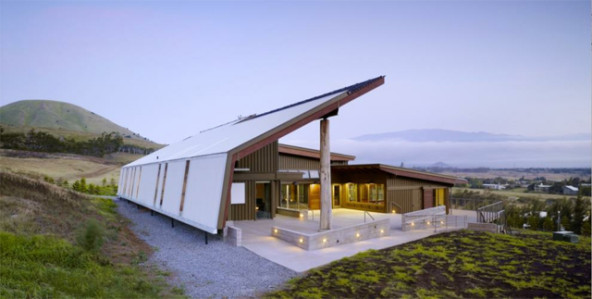 Hawaii Preparatory Energy Lab, certified under the Living Building Challenge in April 2011.
(Photo by Matthew Millman Photography, courtesy of Flansburgh Architects © 2010)
Hawaii Preparatory Energy Lab, certified under the Living Building Challenge in April 2011.
(Photo by Matthew Millman Photography, courtesy of Flansburgh Architects © 2010)
Over the last five years, the Buckminster Fuller Institute (BFI) has been supporting the emergence of a new generation of social entrepreneurs and design pioneers capable of imagining and creating new approaches and solutions to benefit all humanity. BFI has been advancing these visionaries through an annual international design competition called the Buckminster Fuller Challenge. The winners are awarded a $100,000 cash prize to develop their projects
The winner of this year’s competition, which attracted more than 120 applicants, is the International Living Future Institute’s Living Building Challenge, which promotes the sustainable transformation of our built environment by encouraging design and technological innovation to achieve harmony between man-made and natural ecosystems.
Buckminster Fuller was an extraordinary man who strove to reshape the world around him. During an interview with Playboy Magazine in 1972, he said: “Call me Trimtab.” A trimtab is a tiny steering surface found on ship and airplane rudders, which make the movement of large steering surfaces possible. Fuller invoked this metaphor to demonstrate how small amounts of energy and resources can be strategically applied to generate maximum impacts. The winners of the Buckminster Fuller Challenge are selected for their bold and visionary approaches and ability to achieve far-reaching results. Previous winners of the challenge have tackled issues ranging from land use management and marine ecosystem preservation, to alternative transportation and carbon-neutral economies. This year’s winner, the Living Building Challenge, was selected because it fully embodies a comprehensive, anticipatory, and integrated philosophy to solving the world’s most complex problems, particularly for the built environment.
The Living Building Challenge is a third-party building certification program. Unlike other green building certification programs, such as the US Green Building Council’s LEED standard, the Living Building certification is not awarded based on design and performance projections; it is awarded only after the building is completed and has been in operation for at least one year. The creators of the program do not envision it as a competing system to green building standards such as LEED or Passive House, but rather have lauded these existing programs for creating momentum toward a more sustainable built environment. What makes the Living Building Challenge unique is that it is not only a performance standard, but also a design philosophy and even an advocacy tool.
Are you enjoying this article? Read more like this, plus SSIR's full archive of content, when you subscribe.
The Living Building Challenge was launched in 2006 by Jason McLennan as a direct response to the pressures that the accelerating rate of urbanization and impending resource scarcity will place on humanity. It aims to further a design paradigm that minimizes the built environment’s toxic effluents, its destruction of habitats and ecosystems, and its contribution to carbon emissions. To achieve this, the certification program has specified several “imperatives.” Living Building certified structures must demonstrate the highest environmental performance through 100 percent on-site renewable energy generation and wastewater treatment. In addition, buildings can be erected only in previously developed land in order to minimize urban expansion and must be constructed using only ethically and sustainably sourced materials. The final requirement for certification is based on the actual aesthetic design, stipulating that the building be “beautiful and inspiring to its inhabitants.”
Central to the Living Building Challenge is the belief that people are not just building occupants, but participants in an ecosystem. Many who own, work in, or learn at Living Building certified structures share this sentiment. The program promotes the integration of the built environment with its ecosystem, and facilitates a design process that emphasizes a cooperative relationship among nature, buildings, and people. Ultimately, Living Building’s benefits extend much further than a building’s occupants. By eliminating wastewater effluents, they benefit cities’ water utilities; by generating their own energy, they reduce the load on national energy grids; and through sustainable sourcing, they reduce the destruction of nature.
Living Building’s potential as an advocacy tool must also be recognized. It has already driven new policies and institutional practices around the world, demonstrating that not only is real sustainability a powerful proposition, but also an underdeveloped source of opportunities. In fact, the first Living Building certified project was the Omega Center for Sustainable Living, a wastewater facility that overcame “not in my back-yard” resistance through innovative design, and now not only performs an important environmental function but also happens to be a venue for yoga lessons.
If a single building can have such a deep impact, the potential benefits to the planet from entire neighborhoods or cities of Living Buildings are enormous. The Living Future Institute’s Jason McLennan acknowledges that the next challenge is to increase the reach of the design philosophy and increase the scale of the projects. Buckminster Fuller once said: “If you want to teach people a new way of thinking, don’t bother trying to teach them. Instead, give them a tool, the use of which will lead to new ways of thinking.” The winners of the 5th Buckminster Fuller Challenge, the Living Building Challenge, have done exactly that, presenting the world with a new paradigm for the built environment, one that someday might make the existing model obsolete.
Watch a trailer for a documentary about the Living Building Challenge.
Support SSIR’s coverage of cross-sector solutions to global challenges.
Help us further the reach of innovative ideas. Donate today.
Read more stories by Pablo Freund.

